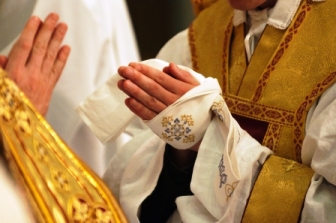So, while going on my blogger feed, I found a post from New Liturgical Movement about a priest who, being his first Mass post-ordination, did it in the Extraordinary Form. Click here for more details. As I was reading it, something from the report caught my eye and curiosity ....
".... After the Mass Fr Valentine gave the manutergium from his ordination to his mother and godchildren."
Em? What? A tradition I haven't heard of in the Latin Mass? Quaeritur: What is this manutergium tradition and/or item the post speaks of?
Latin Mass Sub-Topic: The Manutergium
What?
Generally speaking, New Advent defines it as:
"The name given to the towel used by the priest when engaged liturgically. There are two kinds of manuterges. One serves the needs of the sacristy. The priest uses this at the washing of hands before mass, before distributing Communion outside of Mass, and before administering baptism. It can also be used for drying the hands after they have been washed on occasions not prescribed by the rubrics, but still customary after Mass ....
.... The other manuterge is used in the Mass for drying both the hands at the Lavabo, an action preformed by the priest after the Offertory as he recites the psalm, "Lavabo", and also by the bishop before the Offertory and after the Communion. It is kept on the credence table with the finger-bowl and cruets. There are no ecclesiastical regulations regarding the form and material of this manuterge. The towel, which is used after the Offertory during the recital of the psalm "Lavabo", is usually small (18 in. by 14 in.), only the points of the thumb and two fingers, and not the whole hand, being usually washed (Ritus celebr., VII, n. 6). It usually has lace or embroidery at the ends ..."
So cool! My finger towel actually has a Latin/Liturgical name!!! However, that doesn't really address the tradition in the Latin Mass.
According to a person who asked Fr. John Zuhlsdorf at WDTPRS, the Manutergium and its associated tradition, is, and involved the following:
" ... the custom of a newly-ordained priest giving his mother the maniturgium [manutergium] (or other cloth) with the oils from his consecrated hands, ..."
The manutergium pictured on Fr. Z's posting
Fr. Z decided to respectfully turn this area of minutia to the comment box, as he was unfamiliar with this tradition. The combox poster, a Fr. Maurer of Washington, U.S.A., who has his own blog, "Followers of the Way", was able to add the details of this tradition in co-operation with a seminary colleague of his. Reposted from the comment of January 13, 2012 in the linked Fr. Z post:
Gift of the Maniturgium and 1st confessional stole
On the occasion of their first Mass, it is traditional that the newly ordained priest presents a gift to his parents.
To his mother he gives the Maniturgium , which was used to cleanse his hands; consecrated and made holy when the bishop anointed them with sacred chrism at his ordination. The Maniturgium is a simple white piece of linen that represents the burial shroud of Christ that protected His sacred body during His 3 days in the tomb. The Maniturgium is given to the mother, because she was the first protector of the newly ordained priest, during his time in her womb. The Maniturgium is a reminder to the people of God of His love and protection – especially towards His priests. When the newly ordained priest’s mother is called home to God, she is buried holding the Maniturgium so that all in Heaven and on Earth will know that she is the mother of a priest. And on the last day when we are raised from the dead, she can present the Maniturgium to Christ the Lord and say, “my son too shared in your priesthood.”
To his father, the priest presents his first confessional stole. The stole is the sign of priestly office, and the priest wears it when he engages in holy things, like celebrating the Holy Eucharist and the Sacrament of Penance. In the Sacrament of Penance, we experience God’s justice, mercy and reconciling Love. It was the father of the newly ordained priest who first taught him about justice and mercy. And so the purple stole used to hear confessions, where the priest reconciles the faithful into God’s love, is presented to the priest’s father. And like the mother of the newly ordained, when the priest’s father dies, he is buried holding the purple stole so that all in Heaven and on Earth will know that he was the father of a priest. And on the last day when we are raised from the dead, he can present the purple stole to Christ the Lord and say, “my son too shared in your priesthood.”
While I cannot find if there are any specific prayers in the Ordinary of the Mass as part of this tradition, Of interest, There is some web content about this tradition, and it is even re-appearing in the Novus Ordo!
http://blog.adw.org/2010/06/lost-liturgies-file-the-maniturgia/ - Diocese of Washington, from Monsignor Charles Pope! A YouTube video of the part of the N.O. ordination rite with the manutergium is attached.
http://www.sanctamissa.org/en/sacristy/sacristy-sanctuary-and-altar/manuterges-lavabo-towel.html - information from Sancta Missa, with pictures.
Enjoy. Pax, Julian.

No comments:
Post a Comment